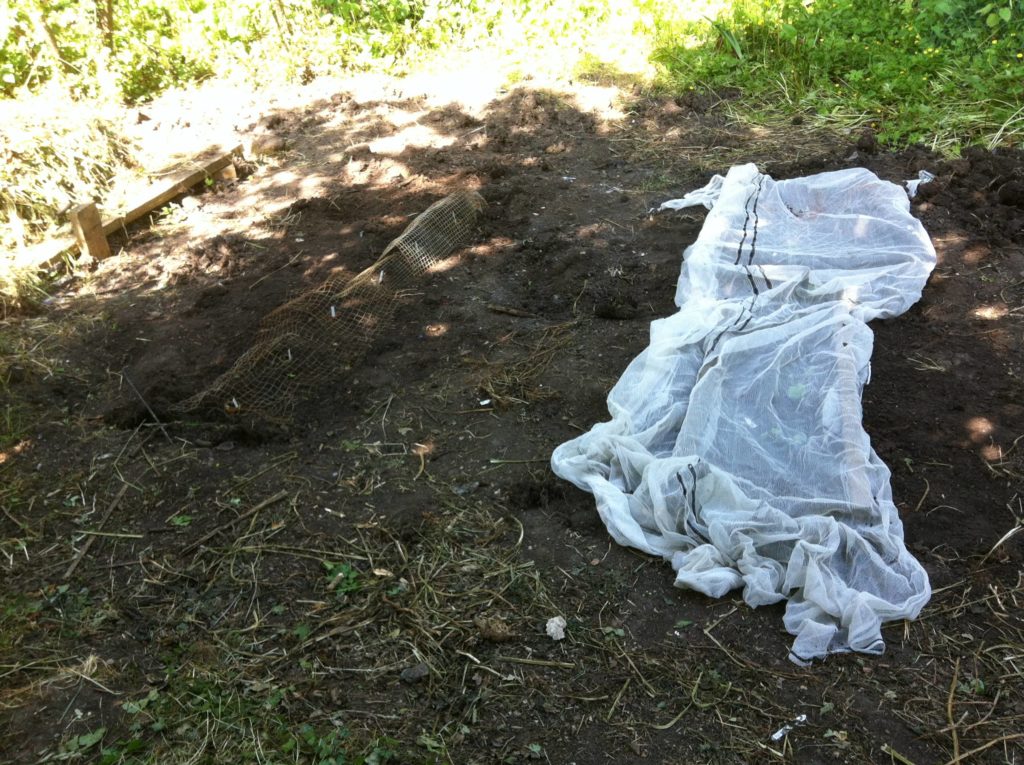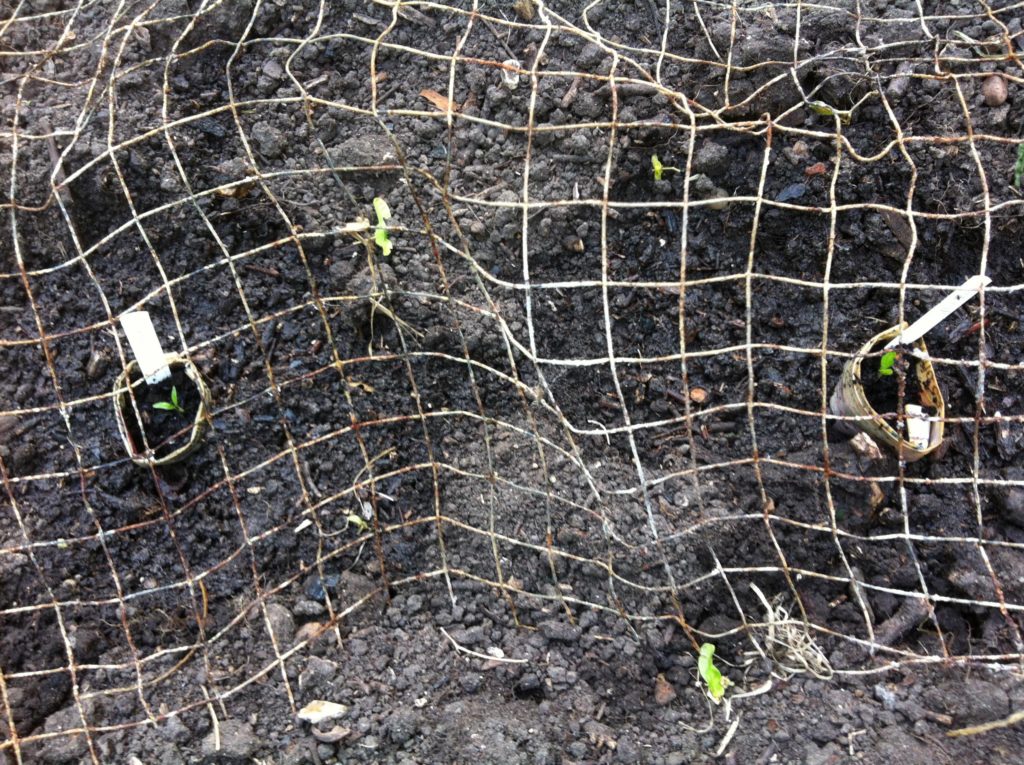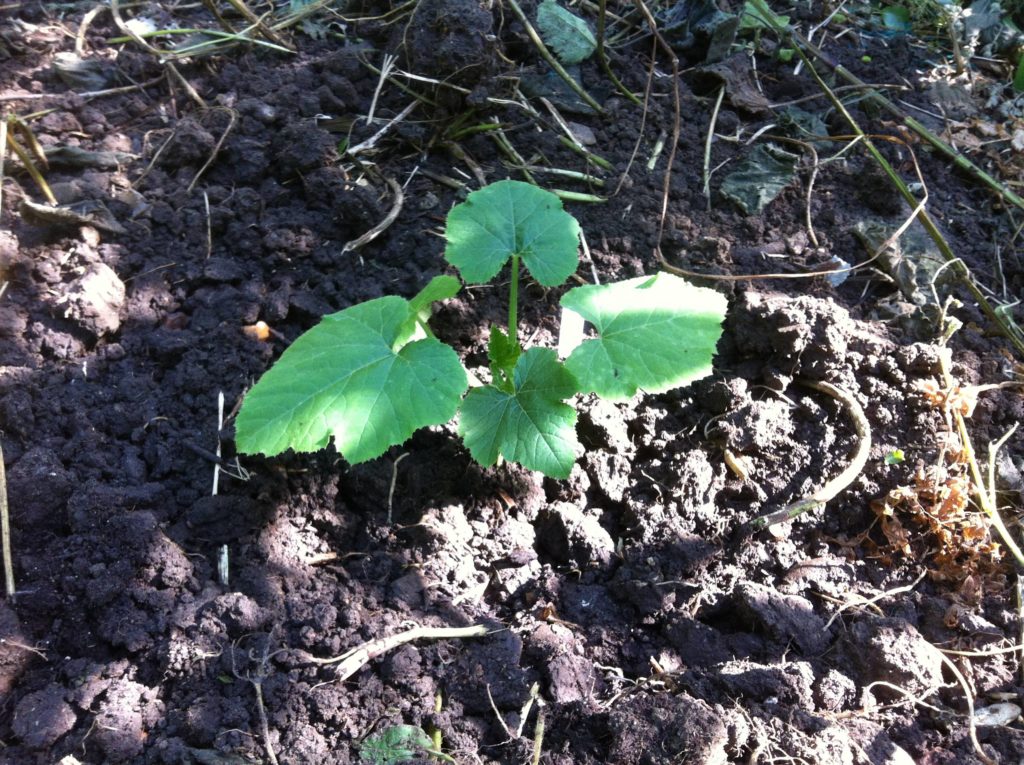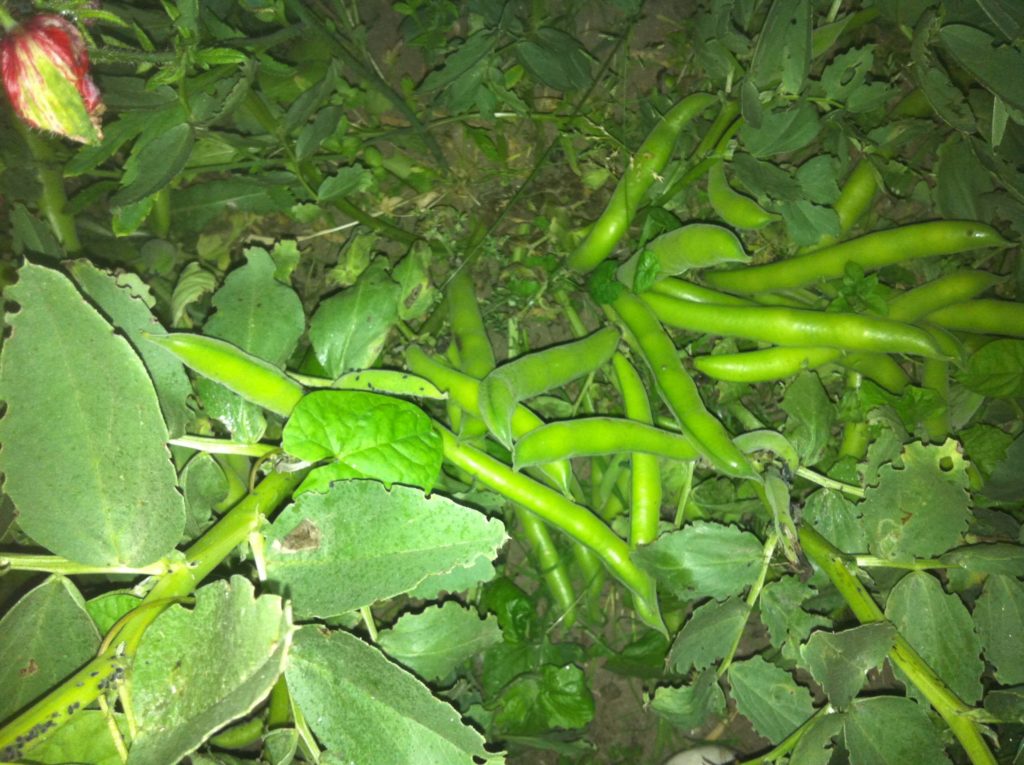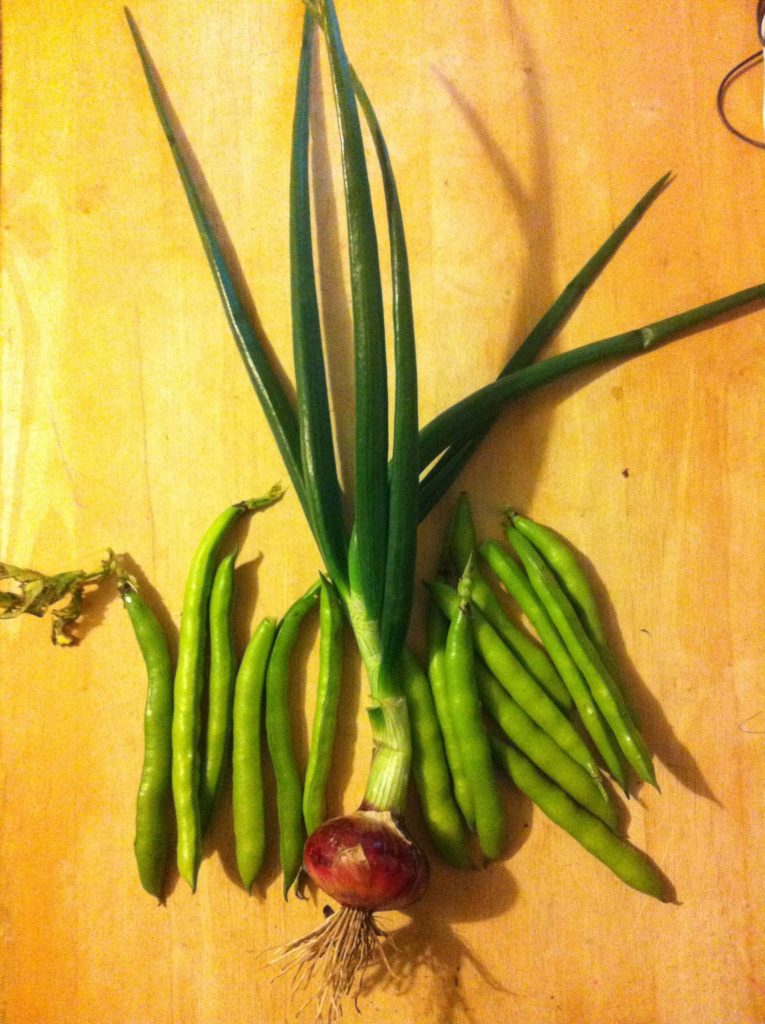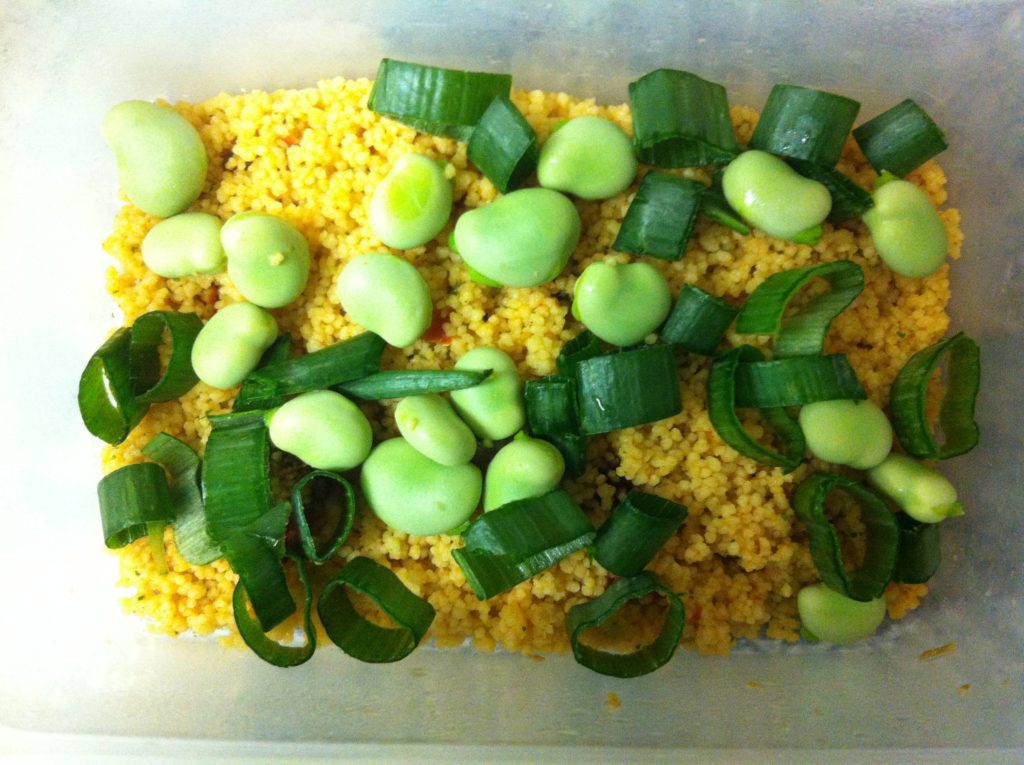We’ve had a couple of busy evenings in the garden. On Wednesday evening my dad came round to help me prepare some space in the vegetable patch for our plants that were in most desperate need of planting. We turned over the soil, but it was so full of roots and stones that we had to dig out a row, sieve it, and fill it back in. It was very time consuming, but I felt it necessary as I had two root crops to plant. I plan to split this vegetable patch into four sections, a classic four crop rotation. We’ve not quite been in this house six weeks yet, and I’ve not been able to spend a whole day in the garden to say with certainty how the sun travels. But my observations are that the far end of the vegetable patch spends the most time in the shade. There are several large plum trees beside it that cast their shadows over this end until the sun is quite high. The other end of the patch gets much more sunlight. So my plan is to grow root veg in the shadiest part, then next to those brassicas, then legumes and then the miscellaneous bed (squashes, tomatoes etc) in the sunniest spot.
So we dug, sieved and filled enough space at the shady end for me to start a row of parsnips and another of swedes. Just to clarify, when I say ‘parsnip’, I am referring to the carrot-shaped root vegetable, and when I say ‘swede’ I am referring to the brassica. As we didn’t move into our house until May, and the vegetable patch was so overgrown, my dad made me some biodegradable pots from newspaper, in which he suggested I planted my root veg. The idea was that we could germinate them in these newspaper pots and plant these pots in their final positions once the patch was clear. So I did as he suggested and germinated my parsnips and swede in some soil in these newspaper pots. However, when we discussed this later, my dad said I shouldn’t have planted parsnips in them, as their roots grow too fast grow and are too sensitive. But by then it was too late, and six had germinated. So when it came to planting them, we gently teased the bottom of the pots away, and planted them into the ground. I’ve not got particularly high hopes for them as I could see coiled roots at the bottom of the pots when I planted them, but hopefully we’ll get something.
Once the parsnips and the swedes were planted in their final positions, we covered them to deter pests. When we were clearing the patch last weekend we found the remnants of a bonfire, in which the previous tenants had attempted to burn all kinds of objects, some more combustible than others. In amongst the ashes was some charred wire fencing. We recycled this to cover the parsnips in an attempt to prevent birds from pulling them up. We covered the swedes loosely with some scaffolding netting (reclaimed from scrap by my good friend Joe) in an attempt to keep cabbage white butterflies off. I plan to make a frame to hold this netting, but for now I’ve just pulled it as taught as I can over some offcuts of wood placed around the row. It was too dark to take a decent photo by the time we had done all of our digging and sieving, but I took this early the next morning:
With these two rows planted, we turned our attention to the miscellaneous bed. We planted out two self-seeded tomato plants of unknown varieties, a small curly-leaved parsley, and our first courgette plant. The latter being a real sense of pride at the moment, as we are really looking forward to growing our first ever winter squashes (I’ve been a little involved in growing them at the community garden, but we’ve never grown them at home before, as we’ve never had the space; last year we tried a dwarf variety in pots, but we didn’t get any fruit). Planting this courgette, a pollinator to the plants that will take pride of place in this bed, seems a step in that direction. We will also of course welcome a bumper harvest of courgettes!
By this point it was getting quite dark, so we decided to pack up and call it a night in the garden. However, dad had been eager to show me the developments at the allotment for the last couple of weeks. The problem is, as soon as I get home from work, any spare time I have I want to spend on the garden, as we still seem so far behind where we should be for the time of year.
I’ve not mentioned the allotment much on here yet, but to summarise: my dad and I had been hoping to get an allotment for years. Dad put his name down on the waiting list nearly five years ago, and at the time he was told that there was a two year waiting list. We planned to work the allotment together, but the two years came and went and still no allotment. Last November, after well over four years of waiting, an allotment finally became available. It was very overgrown and we worked on clearing it together over the winter. In February, just as things were about to get exciting, my wife and I received correspondence from our landlord informing us that he wished to sell the house we were living in. From then on we were too focused on packing and moving and then unpacking and then the new garden, and I’ve barely been back to the allotment. Meanwhile, my dad has been toiling away turning all those years of planning into a reality.
So on Wednesday after we ran out of light in the garden, we rushed to the allotment to try to get a glimpse of it through the darkness. It was the first time I’d seen it for a few weeks, and how it had grown! It was too dark to get a decent photo of the whole plot, but I took the photo above to show just how laden the broad beans were with their fruits. I didn’t want to harvest too much from the allotment, as I feel I haven’t done my fair share of the work. But I took a few broad beans and a fine specimen of a red onion.
I think one of the great things about growing your own food is how much you value the produce once it is finally ready. Take this onion and these beans as an example. On Thursday morning I had an omelette for breakfast, and I couldn’t resist adding some onion tops to the egg mixture. The remainder of the onion tops were added to some couscous along with some of the broad beans for Thursday’s lunch. The onion and most of the rest of the broad beans were used in a stew, which we ate for dinner on Thursday evening, the leftovers of which were made into Cornish-style pasties, which we had for dinner on Friday evening. I was almost reluctant to put the broad bean pods in the compost bin!
Thursday evening I planted many more beans for the garden, mostly runner beans. My fear is that I’ve not got anything like as many brassicas and roots planted as I should, and I’m heavily reliant on what I have now surviving. My thinking is that as long as I’ve got enough beans planted, I could, as a last resort, just fill the gaps with legumes. Ideally I’d have neatly defined beds for my four crop rotation, each densely packed with crops of the same category. But I don’t believe that legumes would do any real harm by being grown in the same bed for two consecutive seasons. They don’t tend to leave diseases in the soil. My understanding is that it’s just a lost opportunity, as they will put nitrogen into the soil, and legumes following legumes will not reap the rewards of the nitrogen in the way that another crop would if they followed legumes.
Then, if we are lucky and the brassicas and roots survive, and the legumes do end up just confined to their share of the vegetable patch, I have had a lot of success in the past growing runner beans up a wigwam made of bamboo canes in a pot. They don’t require much sunlight to grow, so all of the plants that I can’t fit into the legume bed in the vegetable patch could instead be grown in pots in the more shady back yard, or possibly in the much sunnier front garden, if there’s space among the tomatoes that we plan to grow there.
So that’s the situation at present. There are still plenty more plants that we have in pots in the front garden that we are hardening off. I fear other engagements will mean we’ll achieve very little in the garden this weekend. After that it will be back to trying to find an hour or two after work to spend on the garden. But it does finally feel as though things are taking shape. I think my next job should be some more digging and sieving in the root veg patch so that I can sow some seeds. I plan to sow carrots and beetroot. I figure I should sow something from the allium family as companion plants to the carrots. The reasoning behind this being that it is traditionally held that the scent of onions deters the much feared carrot fly. Very neatly, it is also held that the scent of carrots deters the onion fly. I have a packet of spring onion seeds, so I plan to plant these in the near future too.


